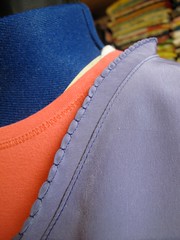I've got several of her projects on my to-do list, but I started off with the Yard-Sale Wrap Skirt in a simple calico cotton. I thought it would make a good beginning project for my sewing students because fitting is minimal, it teaches some nice finishing techniques, and sewing it is quick and fun. Heather's instructions are simple, but brief, so I'd like to detail here the directions I will use to teach my students. Another note, a few mistakes have been noted in this first edition of
Weekend Sewing, including the sizing of this skirt. For a complete list of corrections, click
here.
I'm using 5/8" seam allowances with this pattern.
First is fitting the pattern to the person. Because this is a pretty full skirt, you usually won't have to worry about the hip measurement, but you do need an accurate waist measurement. In the list of
corrections to the book that are posted on Heather's website, she suggests adding skirt panels if you have a larger waist than the pattern allows for. Instead, I'd like to adjust the pattern piece to fit and just use the six skirt panels she calls for in the original directions. This method will use less fabric yardage. To determine how much to adjust the skirt panel, divide your waist measurement by four (because four panels should make it all the way around your waist, with the last two panels used as overlap), add 1.25" to that measurement to account for seam allowances, then compare that measurement to the measurement of the top edge of the skirt panel pattern piece. The difference between the two, we'll call Measurement A. If you need the pattern piece to be larger, cut the pattern piece in half lengthwise and spread the two pieces by the same amount as measurement A. Fill in the gap with tissue paper and tape. If you need the pattern piece smaller, cut and overlap the pattern piece by the amount of measurement A. Then lengthen or shorten each waistband piece by Measurement A. Hold the pattern piece up to your waist to judge the length, then shorten or lengthen according to your preference.
Next is laying out and cutting the pattern. Here's a rough sketch of my cutting layout. I'm using 44" fabric that is NOT a one-way design, which would require more fabric. This took 3.25 yards. If you want to lengthen the skirt, add three times the amount you're lengthening by to the yardage.
Let the fun begin! It's time to start sewing. Stitch the skirt panel side seams together with french seams using the instructions in the book, as well as finishing the final side edges with a narrow hem.
Also, join the waistband and ties together, turn the bottom of the waistband 3/8" to the wrong side and press, and sew the waistband and facing together, all as is instructed in steps 4 and 5 of the book. If you get confused as to which piece is the front of the waistband and which is the waistband facing (the part that will sit next to your skin) hold the piece up to your waist, right side away from you, bottom edge down. If the longer tie is to your left, you're holding up the waistband. The other piece will be the facing.
When I stitched the waistband to its facing, I stitched not only to the end of each tie as she suggests in the book, but I also stitched around the end of the tie and about 6" back the other way, flattening the pressed over edge as I went. I thought it was then easier to turn the end and get a nice point.
Next, stitch the bottom edge of the waistband facing to the waist edge of the skirt, wrong sides of each piece facing up.
Turn, press, pin the bottom folded edge of the waistband in place (the edge will sit about 1/8" below the waist seam to hide it), and edge stitch all around the waistband edges. Experiment with your presser feet to find one that will give you a nice even edge stitch. I use my blind hem foot.
Now all that's left is to finish the hem with a rolled edge! If you have a rolled edge presser foot, or want to try one,
Threads magazine website has a great 3-part post on using this special foot
here.
If you want to hand stitch a rolled hem, here's my favorite way to get a smooth, easy finish. I'll demonstrate the technique using contrasting thread on a scrap of fabric, but you'd of course use matching thread.
First, trim the bottom edge if needed so you have a nice, even line. Then choose a presser foot that will help you make a consistent stitch 1/8" away from the edge.
Press the fabric to the wrong side, so that the line of stitching is just showing on the wrong side. Putting in that line of stitching really helps keep the folded amount of fabric even, which is important. A rolled hem can easily look wonky if the folded amounts aren't consistent.
Bring your threaded needle up through the fold of the fabric.
Then pick up just one or two threads of the fabric about 1/8" beyond the raw edge of the hem, right below where your thread is coming through the fold.
Go back to the fabric fold and stitch through just the fold of the fabric about 1/8".
Continue stitching back and forth from the fabric fold to picking up fabric threads a few times.
Then start to tighten the thread so the hem rolls up and hides the raw edge, keeping just the last few stitches loose so it's easier to see where to stitch next. Keep going!
Please let me know if you found this tutorial helpful!


















